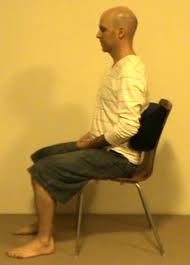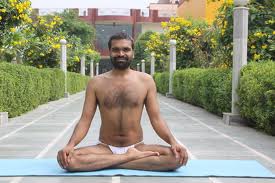Meditation Asana
Meditation Asana share two main features; an upright spine and stability. The spine, up right in extension, provides the mental poise needed for sustained concentration. Stability calms all systems and gives us more internal awareness.
In classic meditation poses the legs cross and the thighs form a wide base of support. The hands rest on the knees further helping to stabilize the spine. The individual parts support the total body alignment with minimum effort, yoga. At first the flexibility of your body is the main determining factor for which of the meditation asana you should use, then time. Remember that you should be comfortable in the pose so as to focus easily on your inner environment. Do not sit in a position that irritates or nags you to release the pose. When all of these poses are accessible to you can explore their different qualities.
The Poses here are listed in order of most effort to remain upright and least stable to least effort and most stable, generally…
Throne Pose
This pose is appropriate for those who cannot sit comfortable on the floor from lack of mobility or injury. It’s also a good way to sit anytime you’re in a chair. Sit in a chair with both feet flat on the ground hip distance apart, hands on the thighs or in a simple mudra, and spine upright. It has a very attentive feeling but requires the most total body engagement to maintain. Keep focusing to the center of the head and harboring in the axis of your balance for a “light head” feeling. You know I don’t mean that kind!
Sukhasana – Happy Pose
Sukhasana is a simple cross legged position. Compared to the other cross leg positions it is not very stable and easy to slouch in but generally better than the Throne pose as it opens the hips. It is better suited for short meditation periods like at the beginning and end of Hatha Yoga classes, for those that cannot yet perform the three classical meditation poses, and for casual sitting. For balance, in this, and each cross legged position, you should change the cross of the legs everyday, practice, or time performing the pose. Bring each foot under the knee of the opposite leg and then slightly rocking your hips from side to side roll the flesh of your buttocks out and widen the sit bones. You can do this pose sitting on the edge of a folded blanket or block to elevate the hips and make an easier time of it. This works because the knees drop lower relative to the pelvis and create less pull that would cause the lumbar vertebrae to round and the whole spine to “sink”. Use something that lifts you just enough to make it feel easy to stay with the chest broad and spine upright. This makes a thick blanket best because you can fold it to your needs.
Vajrasana – Thunder Bolt Pose
Same as Sukhasana, this asana can be useful for short periods. Long holds can be straining to the knees and ankles for some people and in extreme conditions can result in temporary paralysis of the muscles that flex the foot. If this pose is used with a thick cushion between the calves and thighs, or a small angled bench, it can be one of the most comfortable seated poses as the knees are only partially flexed, pressures in the body are evenly spread out, and it’s easy to maintain an upright spine. The downside is that it’s still not as passively stable as the three classical seated poses, described next.
Swastikasana – Auspicious Pose
This is the first traditional meditation asana and similar to the next one, Siddhasana, but is less demanding to accomplish. Pull one heel towards the genitals with the sole against the opposite thigh. Pull in the second foot similarly and tucking the toes between the calf and thigh muscles. Each heel will be on the opposite side of the body. You can stay with this pose for a long time. It is rather stable and much more accessible than the next two.
Siddhasana – Accomplished Pose
This pose is claimed as the best for pranayama, meditation, and realization. It is also said to bring powers or siddhis to the yogi who practices it daily for 12 years. Siddhis are not to be used from a will directed by ego but if they are experienced as divine phenomenon they are fine. Draw one heel inwards and right to the perineum. Draw the second inwards and over the genitals, stacking the ankles on top of one another and placing the toes between calf and thigh. The backs of both heels should be on the midsagittal plane. There are claims that performed properly this pose helps control sexual energy, and those that also say it can cause male impotence. This can be caused primarily by the lower heel traumatizing the arteries responsible for dilating during erection. This makes the earnest practice of siddhasana better for celibates. If you still want to explore the pose without this danger and are able to achieve it, try it with modest elevation of about one inch for the hips and you will find everything much nicer yet still subtly subduing.
Padmasana – Lotus Pose
This is the most stable of the meditation asana. Place the feet on the upper thigh of the opposite leg with the knees close to or touching the floor. The legs are essentially locked into place and this is what makes it possible to use this arrangement in many other poses as well as providing the unparalleled steadiness of this pose. Be especially mindful of the knees when learning padmasana. Do not force you’re feet into the position. With this and the other classical meditation poses keep your arms lightly extended to your knees with the palms up to steady the spine even further. Use the Jnana mudra with the tip of the thumb and index finger touching and the other three fingers extended straight, touching side by side.
Mula Bandha in Meditation
Mula bandha is used to govern the energy in the body during meditation. It is essentially the fail safe for concentration techniques and can be used as the technique itself. In each of these poses for meditation it will have a slightly different dynamic. The more spread apart the space of the perineum the more consciously you will have to focus to maintain it. It is almost naturally occurring in the propped version of Vajrasana and Siddhasana, with the pressure of the heel stimulating the PC muscles.
It is advised for most practitioners to come to meditation after a full practice of asana and pranayama that gives the energy, alertness, and physical comfort needed to stay focused. Those who can be fresh and focused enough to meditate without preparatory practices may do so but will most likely still benefit from preparing with at least kriya and pranayama. I also recommend unplanned meditations whenever conditions are right.
Namaste
George Anthony












